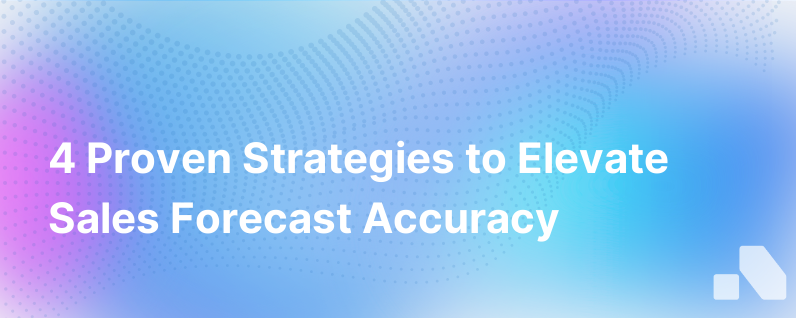
Sales forecasting is integral to business planning, financial projections, inventory control, and the overall strategy of any company. A reliable forecast allows businesses to predict future revenue, allocating resources and capital more effectively to fuel growth. However, many organizations struggle with inaccurate and unreliable sales forecasts. Improving your forecast can lead to enhanced stakeholder confidence, more effective sales management, and ultimately, more successful business operations. Here, we outline four proven strategies that can help refine your sales forecast.
1. Implement A Structured Sales Process The foundation of a credible sales forecast is a well-structured sales process. A standardized sales process, which outlines each stage of the customer journey, provides clear criteria for evaluating the likelihood of a deal closing. This becomes the backbone of your forecasting efforts.
Each stage in the sales process should have distinct exit criteria, qualifying conditions for a lead to progress to the next stage. This helps in scoring deals based on factors such as budget approval, decision-making process, buyer intent, and competitors identified, which is critical for forecasting accuracy.
How to implement:
- Define stages of your sales cycle, from lead generation to closing.
- Standardize qualification criteria for moving a prospect along the funnel.
- Train your sales team on the process to ensure consistent understanding and application.
- Use a CRM system to track and manage the progress of deals throughout the sales process.
2. Leverage Historical Data and Predictive Analytics A robust sales forecast is grounded in historical performance data but refined by predictive analytics. Start by analyzing past sales data to establish baseline trends, including seasonality, annual growth, sales cycle length, and conversion rates at various stages of the sales funnel.
Building upon this foundation, predictive analytics can then harness machine learning algorithms and statistical models to analyze patterns within historical data alongside external factors that could influence sales, such as market trends, economic indicators, and competitive dynamics. This approach makes your forecasts more dynamic and responsive to changing conditions.
How to leverage data:
- Collect and clean historical sales data, paying attention to outliers or irregularities.
- Analyze patterns and trends over time, seeking insights that inform future performance.
- Utilize software tools capable of predictive analytics to identify likely future outcomes based on this data.
- Continually refine models with new data to improve the accuracy of predictions.
3. Engage in Collaborative and Continuous Forecasting Traditional sales forecasting can sometimes fall into a siloed approach where only a few members of the sales team are involved. Instead, forecasting should be a collaborative effort that benefits from the frontline experience of all sales representatives and the strategic overview from management. Continuously updating the forecast allows the business to respond quickly to new information, such as shifts in customer buying behavior or competitive actions.
By engaging with a wider team and updating the forecast regularly, businesses can improve the accuracy of forecasts and create a more adaptable and responsive sales strategy.
How to foster collaboration:
- Encourage regular communication and feedback from the entire sales team.
- Conduct periodic forecast meetings to review and adjust predictions.
- Implement a forecasting tool that allows for real-time updates and visibility across the team.
- Support a culture where updates to the forecast are based on objective analysis rather than gut feelings.
4. Enhance Sales Forecast Accuracy with AI-Powered Tools Artificial intelligence is revolutionizing the accuracy of sales forecasts. AI-powered sales tools, like Aomni, can integrate vast amounts of data at scale, identify complex patterns, and provide insights that would be impossible for humans to discern with the same efficiency.
These tools enable real-time trend analysis, pipeline management, and the ability to incorporate a vast array of variables into forecast models, accounting for nuanced interactions between data points. By leveraging AI, businesses can significantly reduce forecasting errors.
How to implement AI tools:
- Research and select AI-powered sales and forecasting tools appropriate for your company size, industry, and sales complexity.
- Integrate these tools with your current CRM system and ensure they are capturing relevant data from across the business.
- Educate your sales team on how to interpret insights generated by AI and incorporate them into their sales strategy.
- Monitor and measure the impact of AI on forecast accuracy and make necessary adjustments to optimize performance.
Conclusion Improving your sales forecast is an ongoing process that necessitates a combination of structured methodologies, data analysis, team collaboration, and AI-powered insights. By standardizing sales processes, leveraging historical data and predictive analytics, fostering a collaborative forecasting environment, and adopting AI tools, businesses can significantly enhance forecast accuracy and reliability.
An accurate sales forecast is a critical asset for guiding business decisions and ultimately propelling the company toward its growth and revenue objectives. As forecasting technologies evolve, the most successful companies will be those that adeptly integrate these advanced tools with their own internal processes and expertise.
While these strategies provide a solid foundation, organizations should evaluate regularly and remain agile, adjusting their approach to forecasting as needed to respond to the ever-changing business landscape.